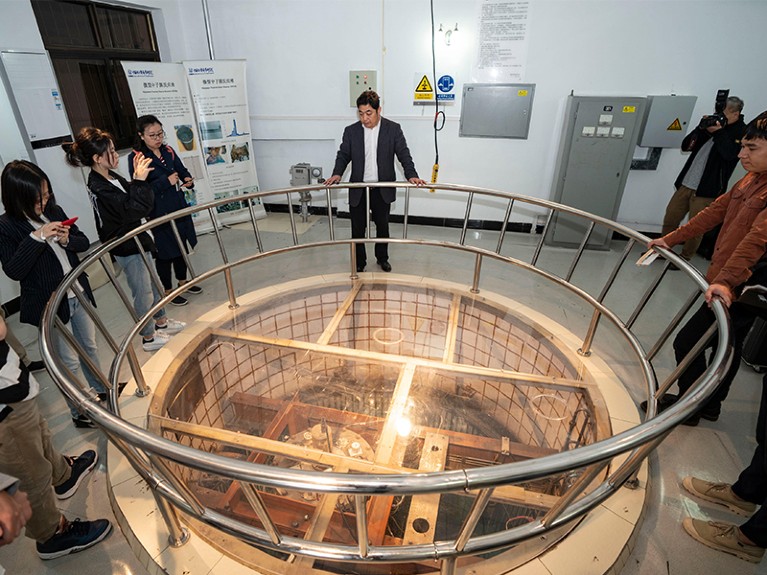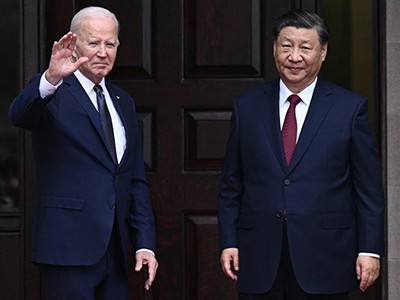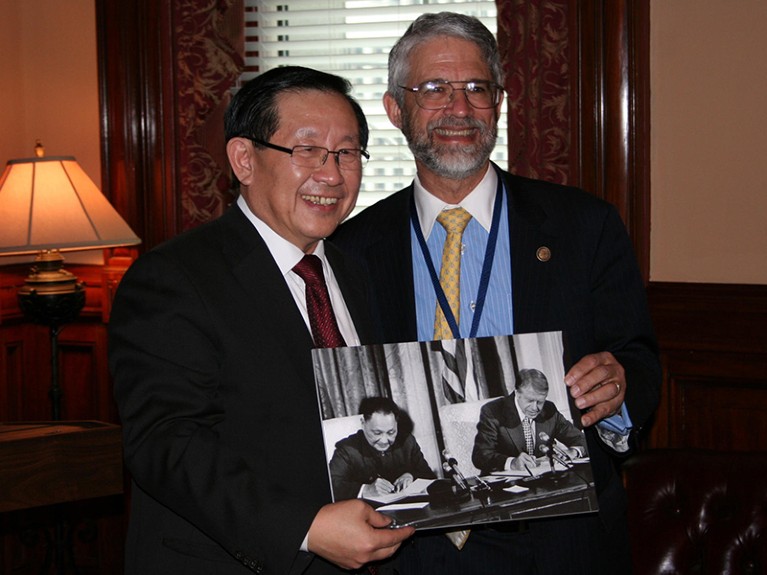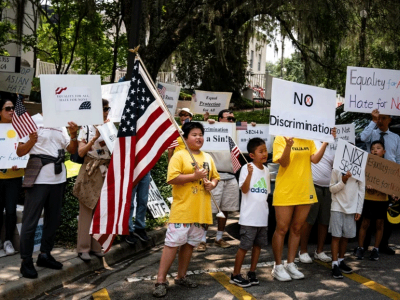
China and the United States cooperated to ensure that miniature neutron source reactors can run on low-enriched uranium.Credit: Xinhua/Cai Yang/Alamy
Two things can be said of the continuing delay to renewing the US–China Science and Technology Cooperation Agreement. The good news is that the two sides are still talking about continuing with the landmark 45-year-old agreement, which has yielded historic levels of research collaboration and student exchanges between the two countries. The bad news is that one or both sides could still walk away. This would be catastrophic. Wisdom and forward thinking must prevail.
Before China and the United States established diplomatic relations on 1 January 1979, there was little or no formal relationship between the two nations, and high levels of mistrust. Science cooperation was identified as offering a relatively swift way to break the ice and begin establishing people-to-people contacts. Then-US president Jimmy Carter and China’s premier at the time, Deng Xiaoping, signed the science agreement before the month was out, on 31 January.
US and China likely to delay renewal of key science pact again
Admittedly, the two countries’ motivations for pursuing scientific cooperation were different. For China, the decision was development-led. The nation was far from the research-driven power that it is now. Today, it boasts some 3,000 higher-education institutions; back then, its annual per-capita income stood at less than US$200. China’s leaders wanted to learn how to build a world-class higher education system, as well as how they might use research to boost economic growth, and, by extension, living standards, as Julian Gewirtz, a historian of China–US economic-research ties, writes in Unlikely Partners (2017). The United States also had a political goal: to steer China away from the orbit of the Soviet Union during the ongoing cold war.
Today, although the two countries can hardly be described as ‘best friends forever’, the fruits of their collaboration are clear. Some 3 million Chinese students have studied at universities in the United States since the agreement was brokered. In 2021, US universities awarded more than 8,000 doctorates to students from China, out of a total of around 25,000 international doctorates. Each country is the other’s biggest research partner, by a considerable margin.
Relations took a negative turn during Donald Trump’s US presidency, from 2017 to 2021. After the start of the COVID-19 pandemic, rhetoric harshened significantly, and this was followed by an erosion of trade and diplomatic links. In the realms of research and higher education, a narrative took hold that there is something inherently suspicious about cooperation between US and Chinese researchers — with an emphasis on known threats such as spying and intellectual-property theft. This has clearly affected collaborations, but has also had a broader reach. There has been surveillance of some innocent researchers. And Florida’s decision to stop universities hiring researchers from China (as well as from Iran and a handful of other countries) would not have seemed out of place during the cold war.
The United States has not been alone in initiating decoupling efforts. From March 2020, China’s government adopted a policy whereby its researchers would no longer be encouraged to publish in international journals. China’s leadership has also taken to talking more and more about self-reliance, one implication of which is less and less need for collaborative effort.
Mutual benefits
John Holdren, a physicist at Harvard University in Cambridge, Massachusetts, was science adviser to former US president Barack Obama and, in 2011, he and Wan Gang, China’s then minister of science and technology, renewed the US–China science pact. That agreement was designed to ensure that the benefits would be mutual, Holdren tells Nature. Those benefits are both national and global.
Collaboration between the two countries on environmental protection includes projects to monitor and improve air and water quality, as well as watershed protection, and projects to reduce electronic waste — benefiting both countries in different ways. The US Environmental Protection Agency has called its relationship with China “one of its most significant”.

In 2011, China’s then science minister Wan Gang and then US science adviser John Holdren renewed the science pact originally agreed between former Chinese premier Deng Xiaoping and former US president Jimmy Carter (depicted in black and white photograph).Credit: Nature and Science/Alamy
When it comes to global challenges, researchers in China, the United States and Europe are cooperating extensively on studying the role of nature in human prosperity1,2. This evolving body of work is foundational to ongoing efforts to incorporate nature into how economies are valued.
Another notable but little-known project aims to reduce the risk of nuclear proliferation. Since 2009, China and the United States have been working together to convert a type of nuclear research reactor called a miniature neutron source reactor so that instead of using highly enriched, weapons-grade uranium as fuel, it runs on low-enriched uranium — which cannot be used in nuclear weapons. China has supplied this type of reactor to a number of countries, including Iran, Nigeria and Pakistan. In a small way, this cooperation has contributed to a safer world.
‘This is exclusion’: Florida law restricts hiring of researchers from seven countries
And then there’s climate change. After a period of silence that began in 2022, the two countries began talking again last year, thanks in no small measure to the long-standing relationship between their then climate envoys, John Kerry and Xie Zhenhua. Last year, California made an agreement with China pledging to cut carbon emissions and transition away from using fossil fuels. Both Kerry and Zhenhua are moving on to new roles, and the legacy of their diplomatic efforts risks being undermined if scientists in the two nations cannot maintain their research ties.
Germany’s handling of its research relations with China could offer lessons. Last month, the German Academic Exchange Service published some sensible recommendations that balance the risks of such collaborations with the benefits.
The document acknowledges the benefits that have come from closer ties, while advocating what it calls a “realpolitik approach” to future links — one based on practical objectives, rather than ideology. Ultimately, it says that universities should be the ones to decide what is mutually beneficial in this regard, while taking the necessary precautions to protect against possible harm.
Risk management
There are, of course, always risks when researchers from different political systems collaborate. And it shouldn’t surprise anyone that big powers spy on each other, says Holdren. But, as with most applications of science in public affairs, from nanotechnology to nuclear energy, the answer to handling risks is to assess them, manage them and mitigate them — always using rigorously tested scientific knowledge.
After 45 years of scientific cooperation, the United States and China risk veering off course. It would be a dangerous folly to bring an end to research cooperation that has such potential to help meet the many challenges faced by China, the United States and the world. In 1979, scientists broke the ice at a time of great tension. As tensions rise once again, researchers could be the foot in the door that keeps communications open.

 Why the US border remains ‘a place of terror’ for Chinese researchers
Why the US border remains ‘a place of terror’ for Chinese researchers
 ‘This is exclusion’: Florida law restricts hiring of researchers from seven countries
‘This is exclusion’: Florida law restricts hiring of researchers from seven countries
 China and California are leading the way on climate cooperation. Others should follow
China and California are leading the way on climate cooperation. Others should follow
 China is mobilizing science to spur development — and self-reliance
China is mobilizing science to spur development — and self-reliance
 China’s research evaluation revamp should not mean fewer international collaborations
China’s research evaluation revamp should not mean fewer international collaborations






